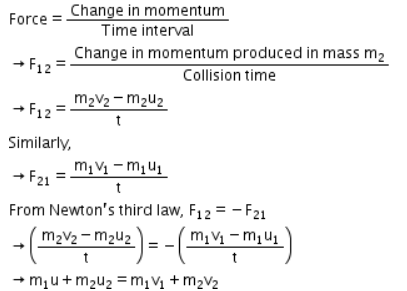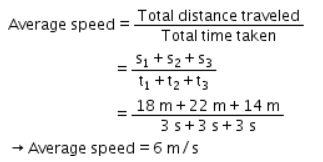Class 9 MAHARASHTRA STATE TEXTBOOK BUREAU Solutions Science Chapter 1 - Laws of Motion
Laws of Motion Exercise 16
Solution 1
Solution 2
A. Distance and displacement
B. Uniform and non-uniform motion.
Laws of Motion Exercise 17
Solution 3
Solution 4a
The displacement of an object is the shortest distance between the start and finish points of its motion.

i.e., Displacement is the shortest distance between an object's initial and final positions.
Solution 4b
Deceleration can be defined as the rate with which the body slows down. It's just opposite of acceleration.
![]()
Acceleration is a vector quantity. It has magnitude as well as direction. So -ve sign in front of acceleration indicates that the object is decelerating or the force is acting
In opposite direction to the motion of object.
Thus, deceleration is negative acceleration.
Solution 4c
- Speed is distance covered by a body in unit time and it is constant in uniform circular motion.
- Linear velocity has the direction along the tangent to the circle formed by the body in uniform circular motion, which is always changing. However, the magnitude of linear velocity remains constant. This continuous change in the direction of motion of the body at each instant accounts for the change in velocity at each instant.
Solution 4d
According to Newton's second law we know that.

Total momentum before collision = Total momentum after collision
This equation implies that if no external force acts on the system of two colliding balls, the total momentum is conserved.
Hence during collision linear momentum remains constant.
Solution 4e
- The rocket's operation is based on Newton's third law. In which the hot gases produced by the combustion of fuel rush out from the bottom of a rocket at breakneck speed. As a result, the rocket accelerates upwards due to an equal and opposite reaction force.
Solution 5a
When the object is falling freely acceleration is uniform.
Gravitational force acting on a mass m which is at a height h above earth's surface when it is falling freely
![]()
Where G is gravitational constant, M is mass of earth, R is radius of earth.
since force is mass × acceleration, acceleration g of mass m from eq. (1) is given by,
![]()
In eq. (2) radius of earth R = 6371 km,
Now, if h << R, we can consider (R+h) ≈ R,
![]()
Hence we can say that, when an object falls freely to the ground, its acceleration is always uniform.
Solution 5b
Action and reaction forces are indeed equal and opposite, but they act on two different bodies. Hence, they do not cancel each other.
Therefore, they result in a change in momentum in the respective bodies.
Solution 5c
- The weight of a cricket ball is greater than that of a tennis ball. As a result, if both are moving at the same speed, the cricket ball has more kinetic energy than the tennis ball.
- As a result, stopping a tennis ball is easier than stopping a cricket ball because less energy is required.
- Because of its greater mass, the change in momentum for a cricket ball after it is stopped by hand is greater.
- The impulsive force produced by the hand to stop the cricket ball is greater than that produced by the hand to stop the tennis ball.
Solution 5d
- A body is said to be in uniform motion when it travels equal distances in equal time intervals, regardless of how small or large the time intervals are.
- As a result, a body at rest has a constant speed of zero and does not even change direction. As a result, the velocity of an object at rest is thought to be uniform.
Solution 6
Newton's First law:
- If the driver suddenly applies the brakes while we are seated in a car, we will be pushed forward. This is due to the fact that we were in motion, and inertia tends to oppose changes in our state of motion.
- We continue to move for a certain distance after getting off a moving bus or train.
Newton's Second law:
- Catching a cricket ball: When a fielder catches a cricket ball, he drags his hands backwards to lengthen the time it takes the ball to lose momentum. This reduces the rate of change of momentum, and thus the force exerted by the ball on the hands.
- Seat belts in a car: When the brakes are suddenly applied or the car collides with an object, the seat belts lengthen the time it takes to move forward, lowering the rate of change of momentum. As a result, the force of impact is reduced, and fatal accidents can be avoided.
Newton's Third law:
- Pistol recoil: When a person fires a gun, he feels a push in the back.
- Swimming: Swimming involves pushing against the water. The water exerts an equal and opposite force on the person, allowing them to move forward.
Solution 7a
Given data:
s1 = 18 m,
t1 =3 s,
s2 = 22 m,
t2 =3 s,
s3 = 14 m,
t3 = 3 s,
Average speed =?

Solution 7b
Given data:
Mass of 1st object, m1 = 16 kg
Acceleration, a = 3 m/s2
Mass of 2nd object, m2 = 24 kg
Now,
According to Newton's Second law of motion.
F = m ×a
F = 16 × 3 = 48 N
Thus,
F = 48 N, m =24 kg
F = m × a
48 = 24 × a
A = 2 m/s2
Solution 7c
Given data:
Mass of bullet, m1 = 10 g
Initial speed of bullet, u1 = 1.5 m/s
Mass of plank, m2 = 90 g
Initial speed of plank, u2 = 0
Now,
By applying law of conservation of momentum, we get
m1u1 + m2u2 = m1v1 + m2v2
Since the bullet becomes embedded in the plank and both move at the same speed in the given case.
v1 = v2 = v
So, we can rewrite the equation as
m1u1 + m2u2 = (m1 + m2)v
10 ×1.5 + 90 × 0 = (10 + 90)v
15 = 100v
⇒v = 0.15 m/s
Solution 7d

Average speed = 2.25 m/s

